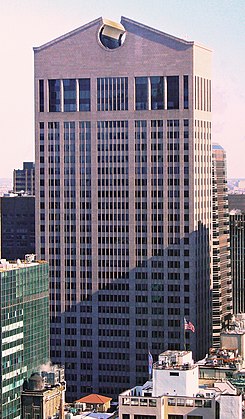550 Madison Avenue
| 550 Madison Avenue | |
|---|---|

|
|
| 550 Madison Avenue | |
| Basic data | |
| Place: | New York City |
| Construction time : | 1980-1984 |
| Opening: | 1984 |
| Status : | Built |
| Architectural style : | Postmodern |
| Architects : | Philip Johnson and John Burgee |
| Use / legal | |
| Usage : | office |
| Owner : | The Olayan Group |
| Technical specifications | |
| Height : | 197 m |
| Height to the roof: | 197 m |
| Floors : | 37 |
| address | |
| Address: | 550 Madison Avenue |
The 550 Madison Avenue , formerly Sony Building or AT & T Building is a 197-meter-high, 37-story skyscraper in New York City .
Located on Madison Avenue (# 550) between 55th and 56th Streets, the building was designed by Philip Johnson and John Burgee in 1979 and completed in 1984. Originally the building, which is clad in pink granite , was built and used as the headquarters for AT&T , but after that the building will belong to Sony until 2011 . In 2016 it was sold to the Saudi Olayan Group and the UK Chelsfield for US $ 1.3 billion.
The building is considered one of the major works of postmodernism . With its silhouette it differs as a distinctive symbol from the steel and glass boxes of the modern age that were used up until then. Johnson connects a number of heterogeneous quotes in a playful and ironic way: The clear structure in the base area, shaft and crown alludes to the buildings of the Chicago school , in particular to Louis Sullivan's postulate of a classic, tectonic structure also for high-rise buildings (“The Tall Office Building Artistically Considered ", 1896). The lower support position cites the Palladio motif (Serliana), but also the facade of the Pazzi Chapel in Florence by Filippo Brunelleschi and the Palladio reception at Claude-Nicolas Ledoux around 1800. Regardless of the granite outer skin, proportions, a three-zone structure and a backward reference point Gallery extension to the Seagram Building in New York from 1958, on which Ludwig Mies van der Rohe and Philip Johnson worked together. Eclecticism as a principle of art and the postmodern citation process are particularly evident in the gable, which at the time provoked the architectural world that was shaped by modernism. In the Anglo-American culture in particular, it is reminiscent of furniture in the style of Thomas Chippendale , especially the cases of grandfather clocks. That's why New Yorkers call the building “that with the Chippendale top”.
Until January 2016, visitors were able to visit the Wonder Technology Lab in the building , where the history of technical communication from Sony's point of view is presented on four floors.
literature
- Christina Haberlik: 50 classics. 20th century architecture. Gerstenberg Verlag, Hildesheim 2001, ISBN 3-8067-2514-4 .
- Francis Morrone: The Architectural Guidebook to New York City. Revised (updated) edition. Gibbs Smith, Layton UT 2002, ISBN 1-586-85211-6 , pp. 256ff.
- Achim Bourmer: New York. = Baedeker New York. 13th edition. Baedeker, Ostfildern 2008, ISBN 978-3-8297-1064-0 , p. 306/7 ( Baedeker Allianz travel guide ).
- Dirk Stichweh: New York Skyscrapers. Prestel Verlag, Munich 2009, ISBN 978-3-7913-4054-8 .
Web links
Individual evidence
- ↑ Skyscraper: Sony Building will probably change hands . In: FAZ.NET . ISSN 0174-4909 ( faz.net [accessed August 12, 2018]).
- ↑ Archive link ( Memento from April 26, 2016 in the Internet Archive )
Coordinates: 40 ° 45 ′ 41 ″ N , 73 ° 58 ′ 24 ″ W.